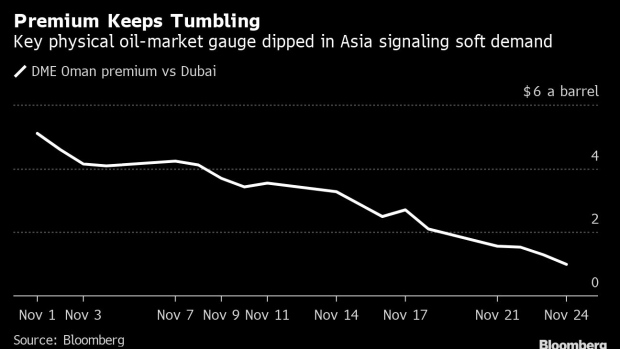Nov 24, 2022
Global Oil Market Flashes Warning Signs on Rising Demand Angst
, Bloomberg News

(Bloomberg) -- The global oil market keeps sending up flares on the outlook for weaker demand. In the latest, a closely-watched gauge of Asian crude consumption tumbled to a seven-month low as surging virus cases in China trigger lockdown-like restrictions in the world’s biggest importer.
The premium of Oman futures over Dubai swaps fell below $1 a barrel on the Dubai Mercantile Exchange on Thursday. It’s plunged about 80% this month.
Oil markets have weakened in November, with a host of widely-watched metrics flashing warning signs and dragging futures prices lower. Among them, the prompt spreads for both Brent crude and leading US grade West Texas Intermediate have dipped into contango, a bearish pricing pattern that indicates ample near-term supply. As the red flags proliferate, Brent futures declined to their cheapest price since January earlier this week.
Expectations for a recovery in Chinese oil demand are fading as daily Covid-19 cases have hit record levels, spurring officials to step up containment measures and movement curbs. Amid the challenging backdrop, some Chinese refiners are refraining from buying cargoes of a favored Russian grade, cutting demand just as traders wait for more details on a Group of Seven plan to cap Russian oil alongside European Union sanctions that start on Dec. 5.
“The fact that Dec. 5 is not injecting any premium suggests the market is sanguine there will be no major supply disruption, at least nothing on a sustained basis,” said Vandana Hari, founder of Vanda Insights in Singapore.
Brent futures headed for a third weekly drop on Friday amid further signs from China that anti-virus restrictions in key cities are multiplying as officials seek to quell Covid-19 outbreaks. In Beijing, the capital that’s home to 22 million people, there’s been a fresh round of curbs, with residents asked not to leave.
The Oman futures-Dubai swaps gauge, which slipped below $1 for one day in April, has mostly commanded multiple-dollar premiums since the invasion of Ukraine. It spiked as high as $15 in March as many buyers started shunning Russian oil, raising the appeal of Mideast crude and boosting the premium.
With physical trading this month mostly concluded for January-loading cargoes, spot premiums for key Persian Gulf grades have declined sharply. While China’s Rongsheng Petrochemical Co. did purchase about 7 million barrels mid-month, that wasn’t enough to lift the sentiment, traders of those grades said.
Meanwhile, another physical market indicator -- inter-month Dubai swaps -- was in a contango early Friday, signaling bearishness for December through April, before flipping back to a slightly backwardated structure, PVM Oil Associates data showed. Before this week, the last time it was in contango was in April 2021.
Brent traded at near $87 a barrel on Friday after hitting $82.31 on Monday, the lowest intraday price since January.
(Updates with latest Dubai swaps in penultimate paragraph.)
©2022 Bloomberg L.P.





